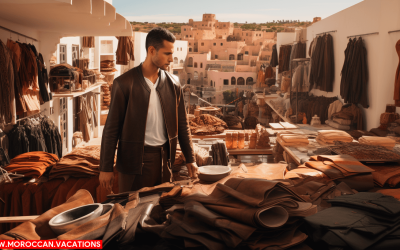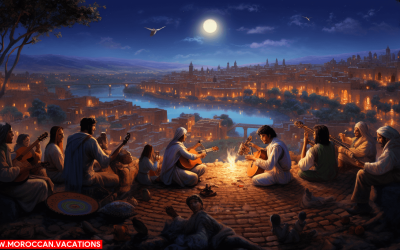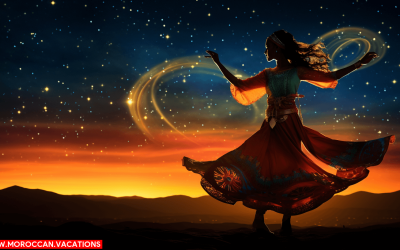The Significance of Moroccan Weddings
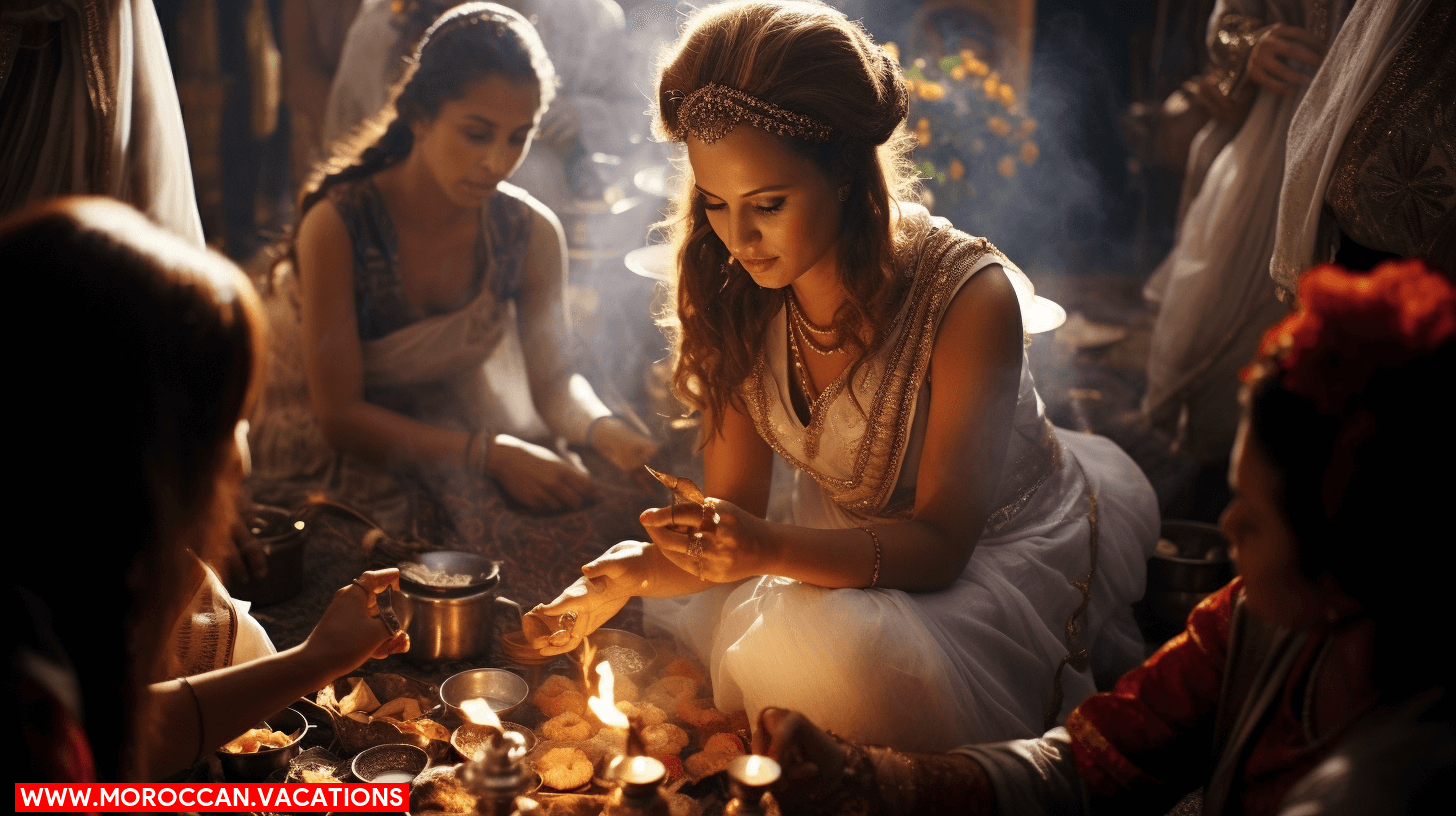

You’re about to embark on a sensory journey like no other! Imagine being swathed in vibrant colors, mesmerizing music, and tantalizing flavors. That’s what you’ll experience at a traditional Moroccan Wedding. But it’s not just about the party. It’s a deep dive into centuries-old customs and rituals that’ll leave you in awe. So, buckle up! You’re in for a cultural treat that’s as rich and diverse as Morocco itself. Let’s unveil the magic together, shall we?
In exploring Moroccan wedding customs, you’ll quickly discover that these nuptial ceremonies aren’t just grand celebrations, but they’re deeply woven into the cultural fabric of Morocco. They’re not only about two individuals tying the knot, but also a symbolic fusion of families, traditions, and values.
Let’s delve into the Moroccan Engagement Traditions. Here, the groom’s family presents gifts to the bride’s family, demonstrating their commitment. The bride, in turn, displays her Bridal Trousseau, an assortment of outfits, jewelry, and household items she’s gathered over her life, reflecting her personality and aptitude. This trousseau isn’t just for show—it’s a testament to her readiness to build a new home.
The significance of these customs goes beyond mere tradition. By showcasing the Bridal Trousseau, the bride asserts her individuality, signaling her freedom to express herself within the boundaries of the marital alliance. These traditions, steeped in symbolism, empower the couple as they begin their journey together. Essentially, they’re more than customs—they’re a celebration of freedom, mutual respect, and the coming together of two lives. So, when you’re invited to a Moroccan wedding, know that you’re witnessing a vibrant embodiment of cultural pride and personal liberty.
Unforgettable Pre-Wedding Festivities
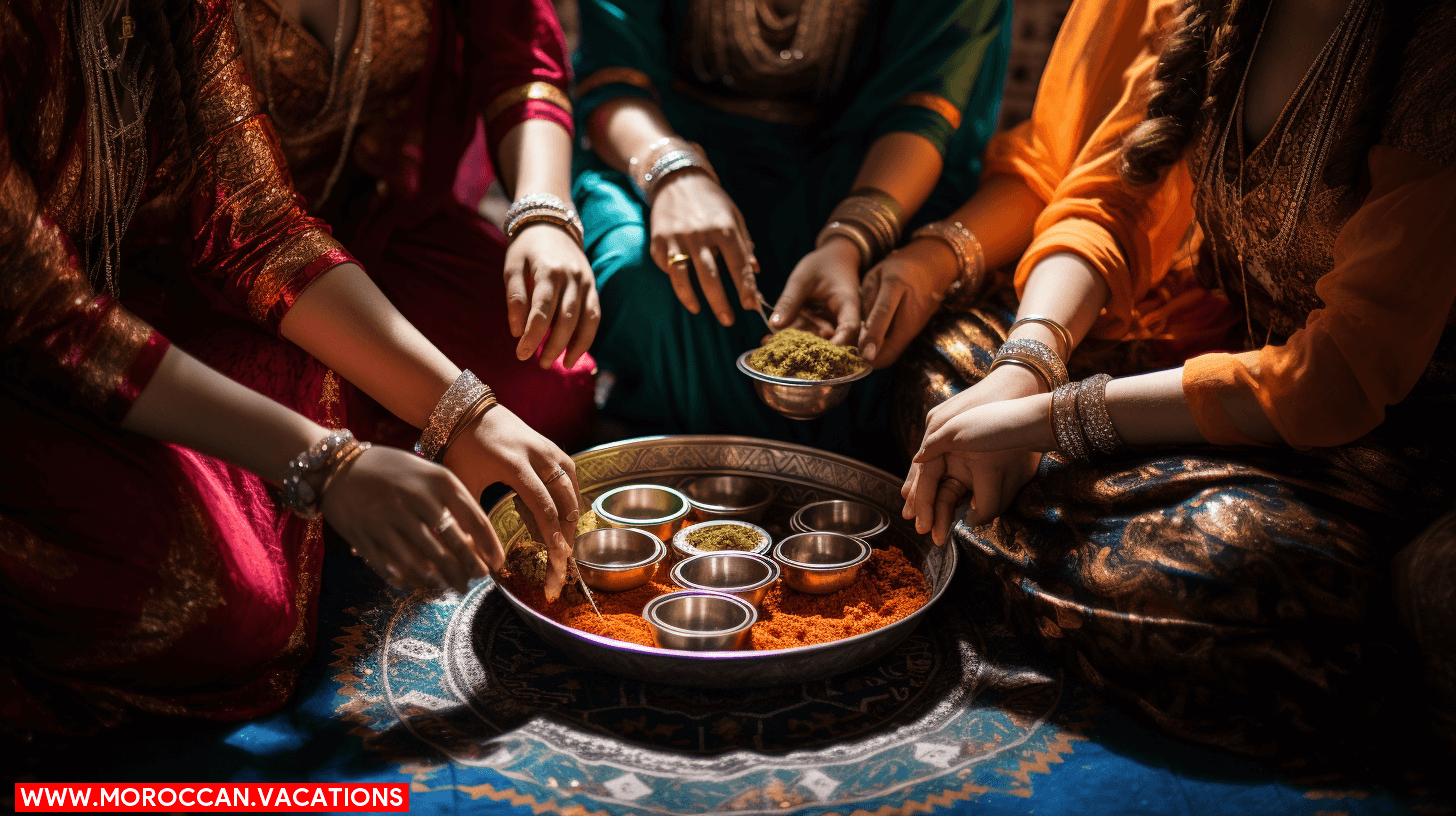

Diving into the unforgettable pre-wedding festivities, you’ll find a flurry of vibrant traditions that both honor the heritage of Moroccan Culture and set the tone for the upcoming matrimonial union. This journey begins with the Engagement Traditions. As a symbol of commitment, the groom presents his bride-to-be with a golden jewelry set, usually a necklace and earrings. This isn’t just an exchange of gifts, but a solemn promise of their impending life together.
Next, you’ll experience the Bridal Showers, a women-only affair where the bride is pampered and prepared for her big day. It’s a time for bonding, laughter, and advice. The bride is bathed in a traditional hammam, signifying purification. Then, beautifying rituals follow, including the application of henna on her hands and feet. This intricate art is not merely decoration, but a token of joy, protection, and good luck.
These pre-wedding customs are far from just formalities. They’re a life-enhancing experience, giving you a taste of the freedom, unity, and love that’s central to Moroccan society. So, as you delve into these traditions, you’re not just observing, but becoming part of a rich, enduring tapestry of Moroccan life.
The Mystical Henna Party
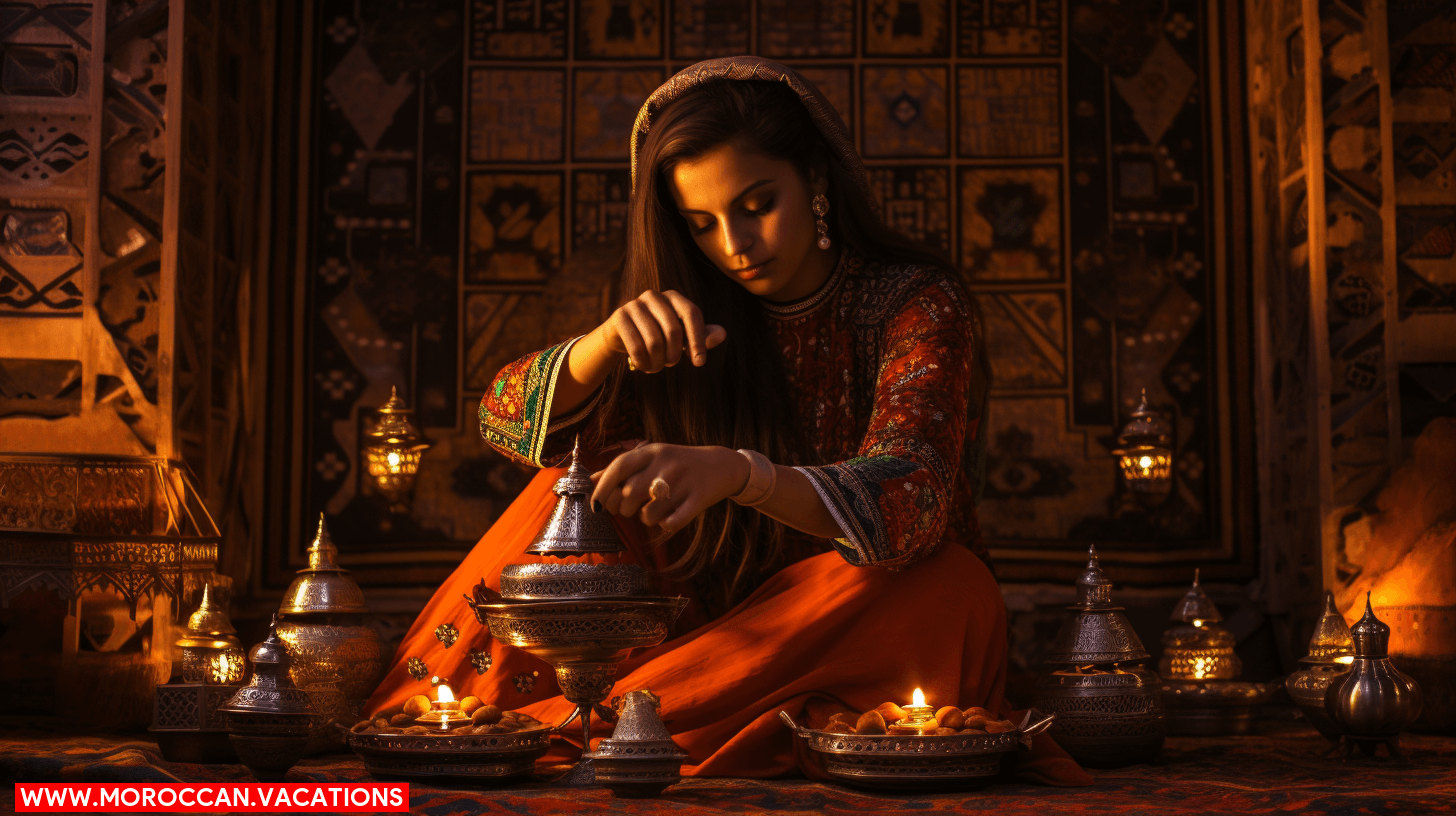

You’ll find that no Moroccan wedding celebration is complete without the mystical henna party, a significant event filled with symbolism and tradition. Henna symbolism is deeply etched in Moroccan culture, with each artistic design telling a story of love, prosperity, and protection.
The henna party is typically held a few days before the wedding. During this event, a henna artist applies intricate patterns onto the hands and feet of the bride. These designs are meant to bring good luck and ward off evil spirits. The henna process is a cherished social gathering with music, dancing, and feasting.
Here’s a glimpse into the henna symbolism with a table:
| Symbol | Meaning | Design |
| Peacock | Beauty, purity | Elaborate peacock feather patterns |
| Flowers | Joy, happiness | Floral motifs |
| Vines, leaves | Devotion, loyalty | Vine-like swirls |
The Grandeur of the Wedding Kaftan
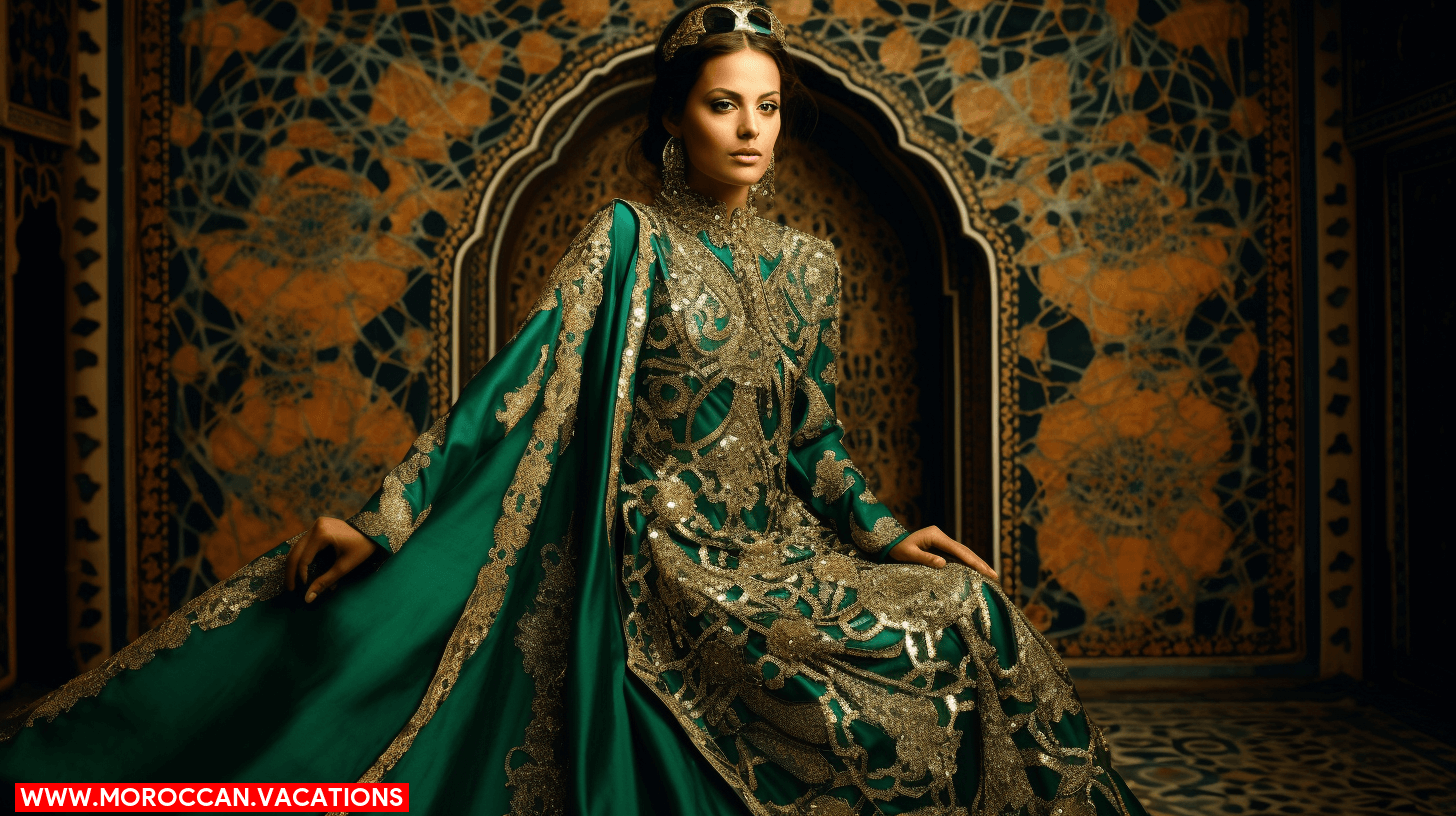

Often, after the joyful henna party, you’ll find yourself captivated by the sheer grandeur and elegance of the traditional Moroccan wedding kaftan.
Here’s your chance to appreciate the fine details that contribute to the kaftan’s grandeur. An essential part of the Moroccan wedding wardrobe, the kaftan has undergone a fascinating evolution, maintaining its traditional roots while embracing contemporary fashion trends.
- Kaftan evolution: From a simple, loose-fitting garment, the kaftan has evolved into an elaborate, detailed masterpiece adorned with intricate designs and opulent materials.
- Symbolic embroidery: The kaftan often features symbolic embroidery, each stitch carrying a unique meaning and blessing for the bride.
- Luxurious fabrics: Silk, velvet, and chiffon are commonly used, adding to the kaftan’s elegance and comfort.
- Jewel embellishments: Beads, sequins, and precious stones often grace the kaftan, reflecting the bride’s beauty and the celebration’s joy.
As you delve into the vibrant world of Moroccan weddings, you’ll discover that the kaftan is more than just a garment. It’s a symbol of heritage, a work of art, and a treasured piece of Moroccan culture that resonates with freedom and individuality.
The Majestic Amariya Procession
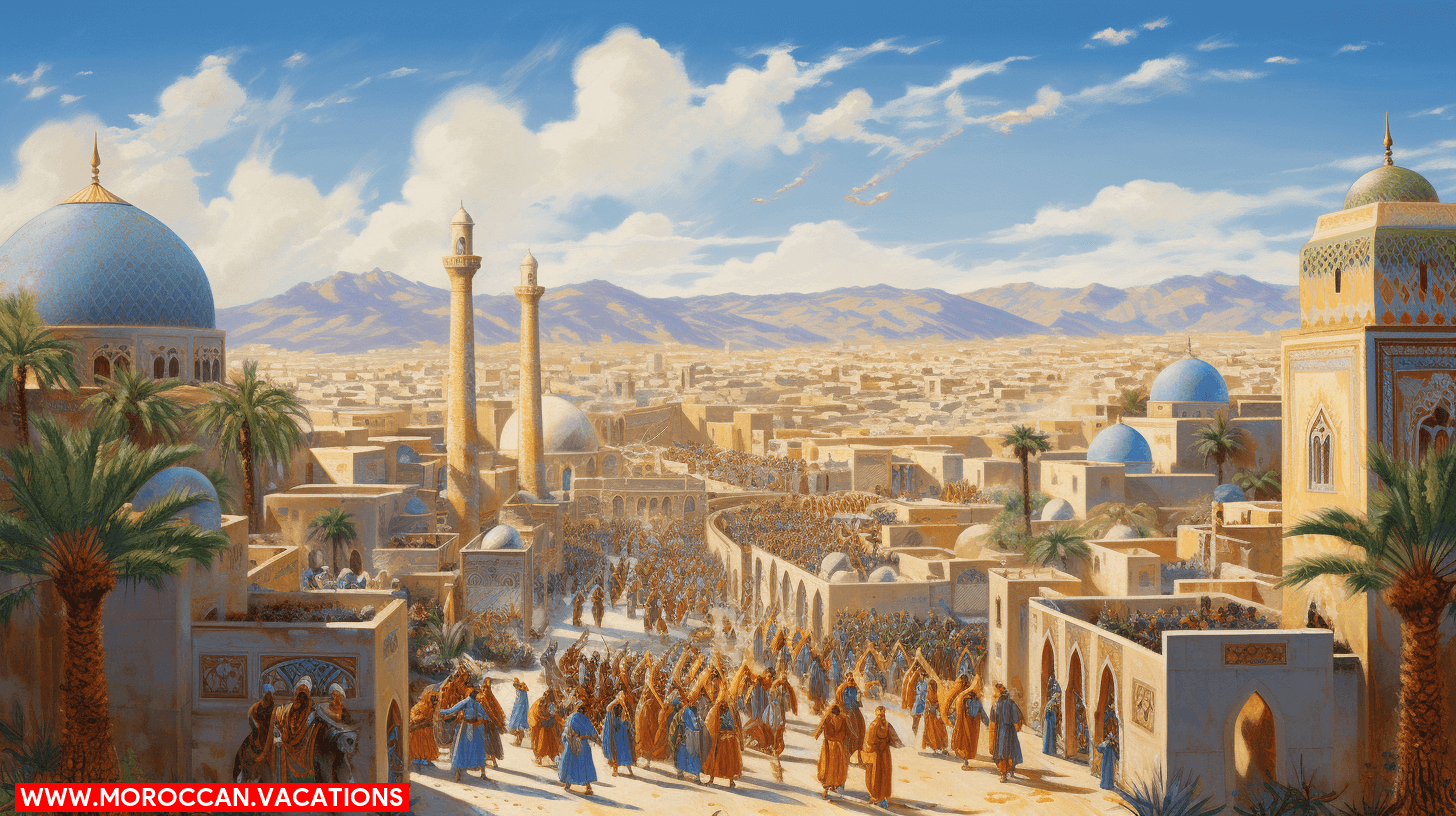

Moving on from the grandeur of the wedding kaftan, let’s now lift the veil on the majestic Amariya procession, another integral part of a traditional Moroccan wedding. The Amariya is a beautifully decorated palanquin, a testament to Moroccan artistry and Amariya craftsmanship. It’s a structure that’s meticulously crafted and lavishly adorned, able to carry the bride and groom high above the crowd.
Just imagine yourself in this procession, sitting atop an Amariya, held aloft by strong bearers. You’re the center of attention, the crowd’s eyes fixed on you, admiring and cheering. It’s not just a procession but a parade of joy, an expression of community celebration, and a testament to your freedom to love and be loved.
The procession planning is no easy task, requiring careful coordination and detailed organization. It’s a procession of music, dance, and jubilation that winds its way through the streets, culminating in the couple’s entrance into their new home.
This Amariya procession isn’t just an event. It’s a journey, a part of your life’s narrative that’s as meticulously crafted as the Amariya itself. It’s a testament to love, to community, and to the rich traditions that make Moroccan weddings a truly unforgettable experience.
The Rituals of the Wedding Ceremony
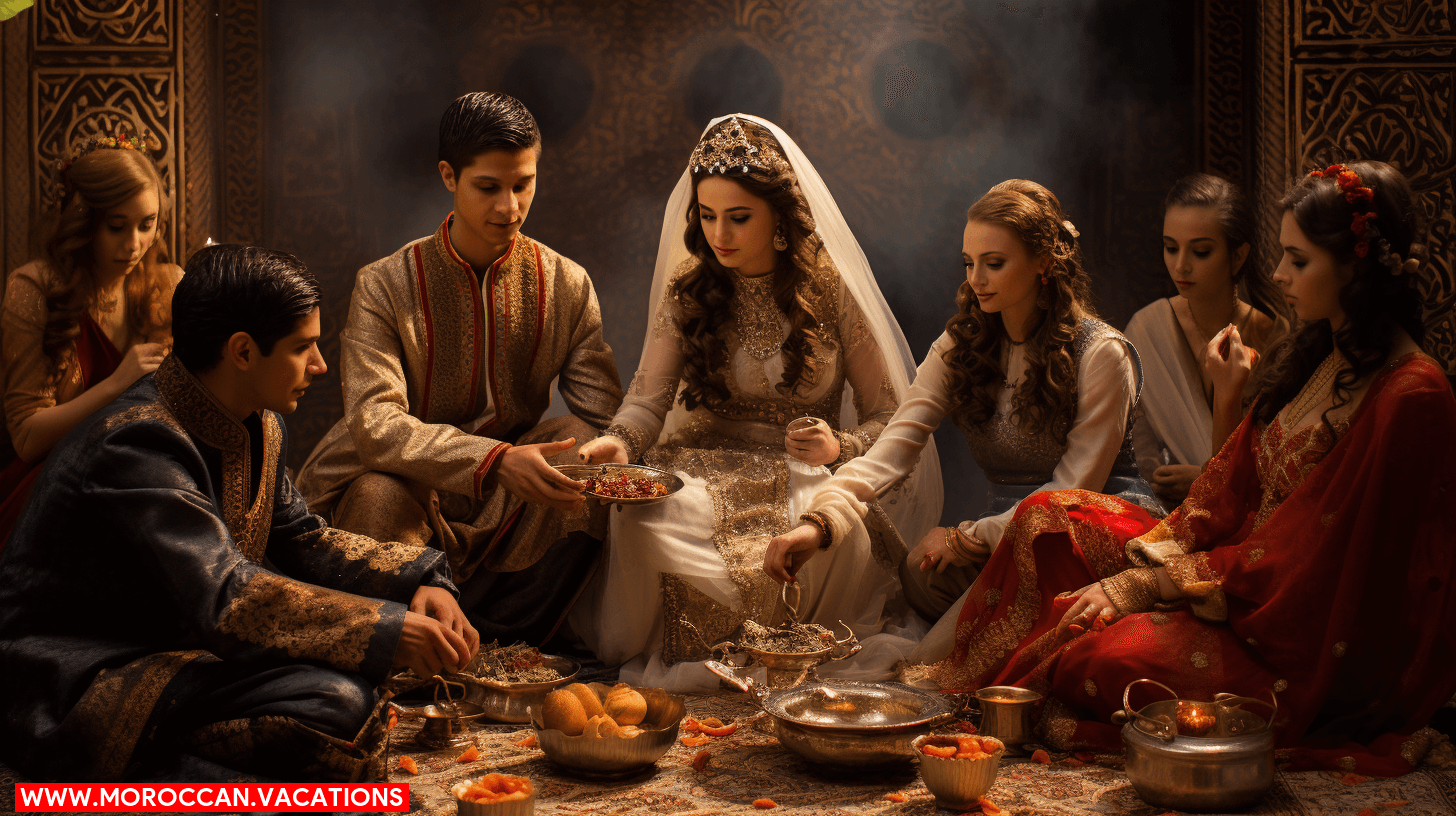

While you’re captivated by the spectacle of the Amariya procession, it’s the rituals of the wedding ceremony that truly bind your commitment in the traditional Moroccan style. The ceremony is a blend of ancient customs, rich with symbolism and steeped in heritage.
The significance of the Bridal Trousseau is profound; it’s not just about beautiful garments, but a demonstration of the bride’s status and family wealth. It’s a collection of new clothes, linens, and other essentials that the bride will bring into her new home.
The Grooms’ Traditional Roles are also of paramount importance. The groom:
- Provides the Mahr: an obligatory gift to the bride as a sign of commitment.
- Participates in the Henna ritual: where he gets a small henna tattoo as a symbol of fertility and protection.
- Leads the Amariya procession: He sits on a decorated platform carried by strong men, displaying his pride and readiness to protect his bride.
- Takes part in the Fatha: He officially asks for the bride’s hand from her father, cementing the union.
These rituals blend to create an unforgettable celebration, deeply connecting you to Moroccan heritage, while allowing you to taste the freedom of a love that’s bound by tradition.
Moroccan Wedding Cuisine Delights
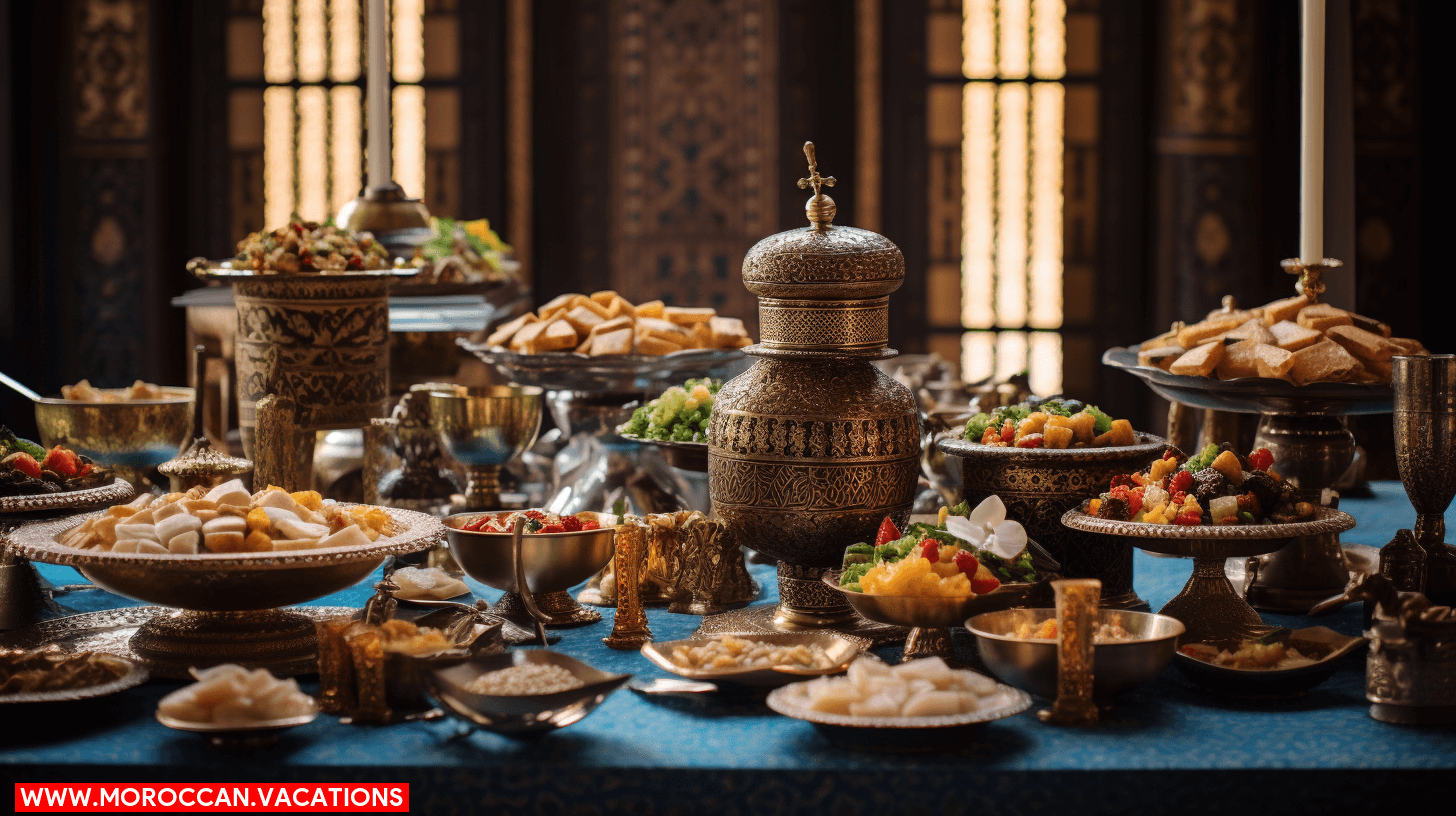

In the grandeur of traditional Moroccan weddings, you’ll find yourself enthralled by the delightful array of cuisine on offer. The dishes served are a testament to the country’s rich culinary influences, with flavors hailing from Berber, Arab, and French traditions.
Imagine the mouthwatering aroma of succulent, slow-cooked lamb or beef, known as Mechoui, spiced to perfection with Ras EL Hanout, the heady North African spice mix. The iconic couscous, a staple at any Moroccan celebration, is served with a medley of vegetables and a savory broth. Guests also savor traditional Tagines, slow-cooked in earthenware pots, featuring ingredients like prunes, almonds, and olives.
The dessert selection, however, is the crowning glory. You’ll be spoilt for choice with an array of sweetmeats like the flaky pastilla au lait, honey-drizzled chebakia, and the nutty, orange blossom-infused Sellou. And let’s not forget the Moroccan mint tea, a symbol of hospitality, often served with a side of delicious almond-stuffed dates.
In a Moroccan wedding, the cuisine is not just a meal, it’s an immersive experience, a cultural journey that tantalizes the senses and leaves you craving more. So next time you’re invited to such an event, be prepared to feast like royalty.
The Intimate Hamam Ceremony
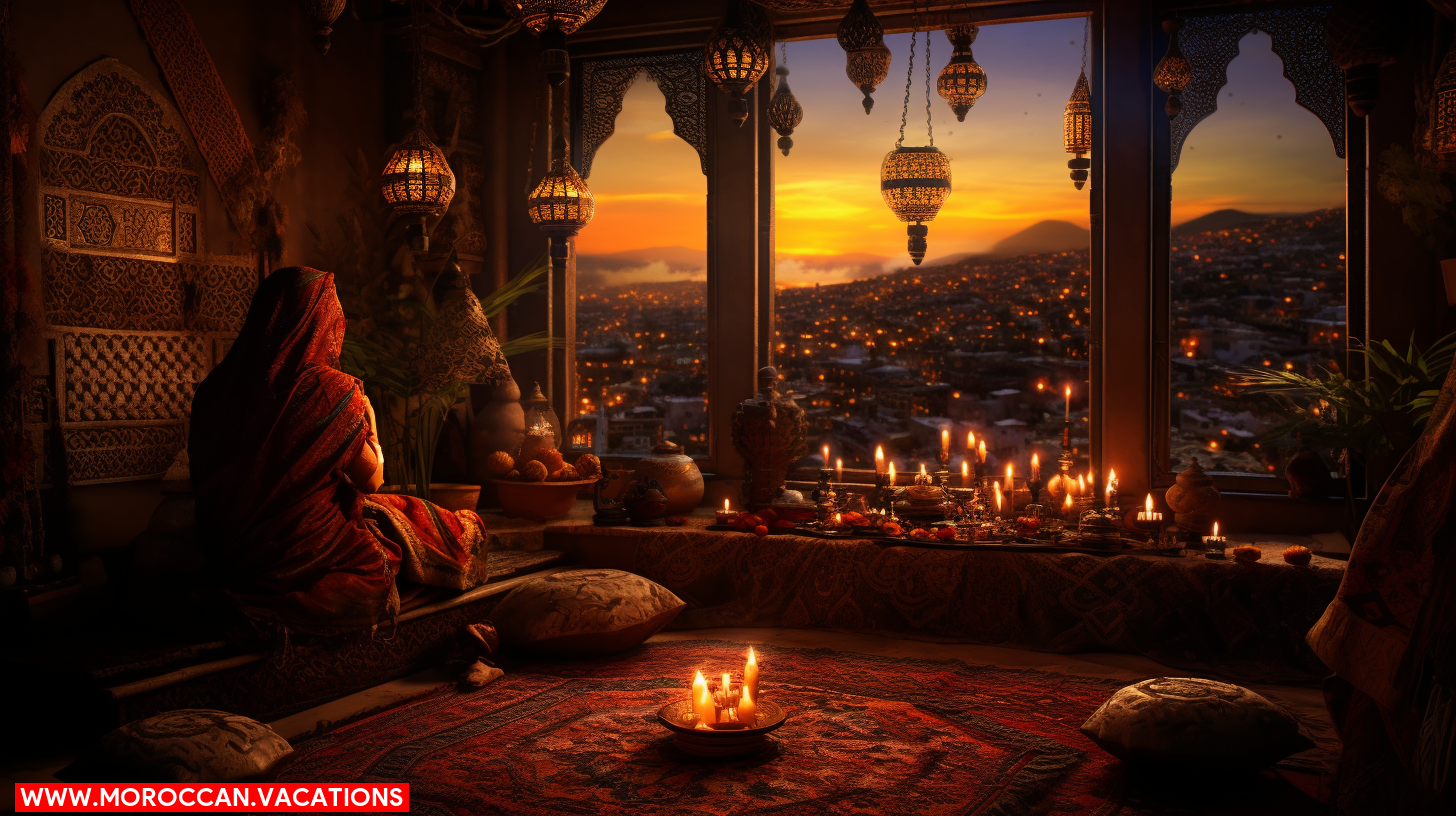

You’re sure to be captivated by the intimate Hamam ceremony, a vital part of traditional Moroccan wedding celebrations. This ritual, replete with Hamam’s symbolism, signifies the Bridal purification and the transition into marital life.
- Preparation: The bride, accompanied by female relatives and friends, enters the Hamam – a traditional Moroccan bathhouse. Here, she’s lavished with sweet-scented soaps and oils, preparing her for the purification process.
- Gommage: This is a body scrubbing ritual done with a ‘kessa’ glove. The exfoliation removes dead skin, representing the shedding of the bride’s past life.
- Ritual Bath: After the exfoliation, the bride is bathed in warm water, symbolizing the cleansing of her spirit and soul. It’s an essential step in the purification process.
- Relaxation and Beautification: Post bath, the bride relaxes while her hair is washed and styled. Henna designs are then intricately drawn on her hands and feet, signifying joy and beauty.
The Hamam ceremony is much more than a mere bath; it’s a symbolic journey of transformation. As you can see, every step in this intimate ritual holds deep meaning, echoing the rich traditions of Moroccan wedding customs.
The Final Day: Malhun Music and Dance
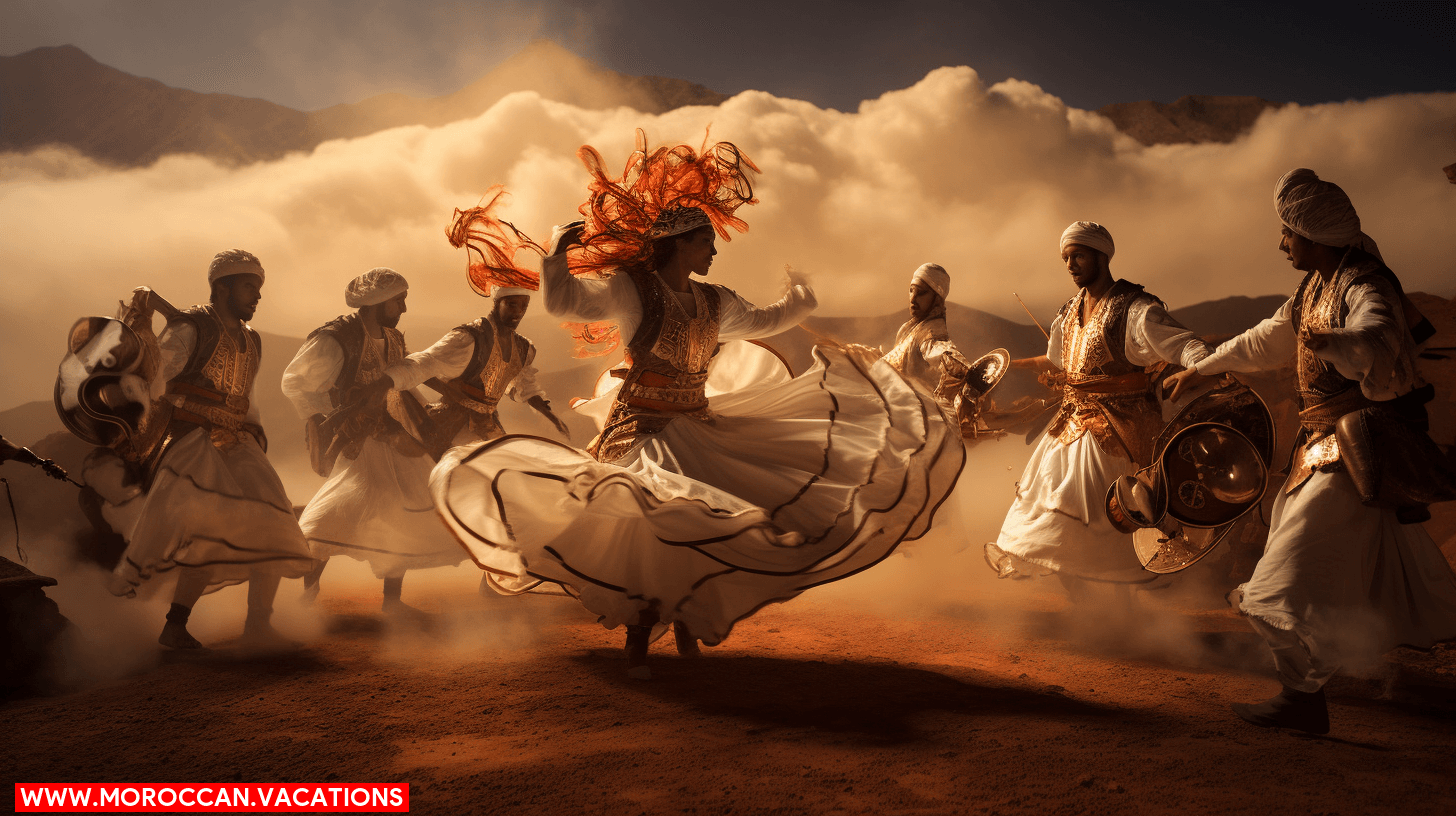

After immersing yourself in the symbolic Hamam ceremony, prepare to be entranced by the vibrant rhythms and traditional dance of Malhun music, the highlight of the final day of a Moroccan wedding. The air becomes electric as the Malhun instruments start to play, creating a mystical atmosphere that invites you to lose yourself in the joyous celebration.
The use of unique Malhun instruments like the lute, tambourine, and the violin create a captivating rhythm that’s impossible to resist. The musicians’ skilled hands manipulate these instruments, producing melodies that echo the rich Moroccan heritage. This performance is more than just music; it’s an authentic representation of the Moroccan soul.
As the music plays, dancers in their traditional Dance Attires take the stage, their movements in perfect harmony with the pulsating rhythms. Women are adorned in vibrant Kaftans and gold jewelry, while men wear long, loose Djellabas. The dancers’ fluid movements, combined with the vivacious music, tell a story of love, unity, and celebration.
In this final act of the wedding, you’re not just a spectator. You’re an active participant, free to join the dance, free to express your joy. So, let loose and immerse yourself in the rhythm of Malhun, the perfect end to a traditional Moroccan wedding.
Introducing Ayoub Karbachi, a brilliant wordsmith and curator of the Moroccan Vacations website. Prepare to immerse yourself in mesmerizing narratives and extraordinary moments, as he unveils the allure of Morocco's captivating destinations like never before.
Related Articles
From Tanneries to Luxury Boutiques: A Journey Through Morocco’s Leather Industry
Embark on a captivating journey through Morocco’s vibrant leather industry, from traditional tanneries to upscale boutiques. Explore the rich heritage and craftsmanship behind each piece, unveiling the essence of Moroccan culture and luxury.
A Guide to the Most Popular Moroccan Festivals and Dates
Discover the vibrant tapestry of Moroccan culture with our comprehensive guide to the most popular Moroccan festivals and their dates. From colorful celebrations to traditional rituals, immerse yourself in the rich heritage of Morocco’s diverse festivals.
Unraveling the Grace and Rhythm of Traditional Moroccan Dance Styles
Explore the mesmerizing world of traditional Moroccan dance styles, as we unravel the grace and rhythm deeply rooted in cultural heritage. Discover the vibrant movements and rich history behind these captivating dances.

